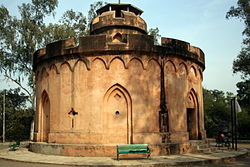Flagstaff Tower
Flagstaff Tower is a one-room, castellated tower, built around 1828 as a signal tower, located in Kamla Nehru Ridge near the present-day North Campus of Delhi University in Delhi, India.[1] It was here that many Europeans and their families sheltered on 11 May 1857, during the Siege of Delhi by the rebels at the beginning of the Indian rebellion of that year,[2][3] waiting for help to arrive from nearby Meerut. [4] Built by the British Indian Army, the building was part of the British cantonment and was used as a signal tower. Before forestation started in 1910, the area where the tower was built was the highest point on the ridge and was mostly barren, covered with low-lying shrub. Today it is a memorial and "protected monument" under Archaeological Survey of India.[2]
HistoryEdit
Flagstaff Tower played an important role during the Indian Rebellion of 1857, when Delhi was captured by the rebellious East India Company forces. On the morning of 11 May 1857, when the sepoys started hunting for and killing European personnel and Christian Indians in the Cantonment, Civil Lines and the walled city of Delhi, the survivors started fleeing towards the Tower.
A month later the Company army returned to capture Delhi, which was now with the sepoys. On 7 June, they faced stiff resistance from the sepoys at the Flagstaff Tower. A fierce battle followed which led to the killing and wounding of a great number of soldiers. However, by five in the evening the ridge had been recaptured and was now under British control.
See alsoEdit
ReferencesEdit
- ↑ "Flagstaff Tower, Old Delhi". victorianweb.org. Retrieved 5 September 2012.
- ↑ 2.0 2.1 "DU plans a heritage walk through the Ridge". The Hindu. 13 August 2012. Retrieved 5 September 2012.
- ↑ "Tales of the ridge monuments". The Hindu. 29 July 2012. Retrieved 5 September 2012.
- ↑ Jones, p. 203
External linksEdit
- Rosie Llewellyn-Jones (2007). The Great Uprising in India, 1857-58: Untold Stories, Indian and British. Boydell & Brewer. ISBN 1843833042.
- William Dalrymple (2006). The Last Mughal: The Fall of a Dynasty, Delhi 1857. Penguin Viking. ISBN 0670999253.
- Flagstaff Tower at wikimapia
